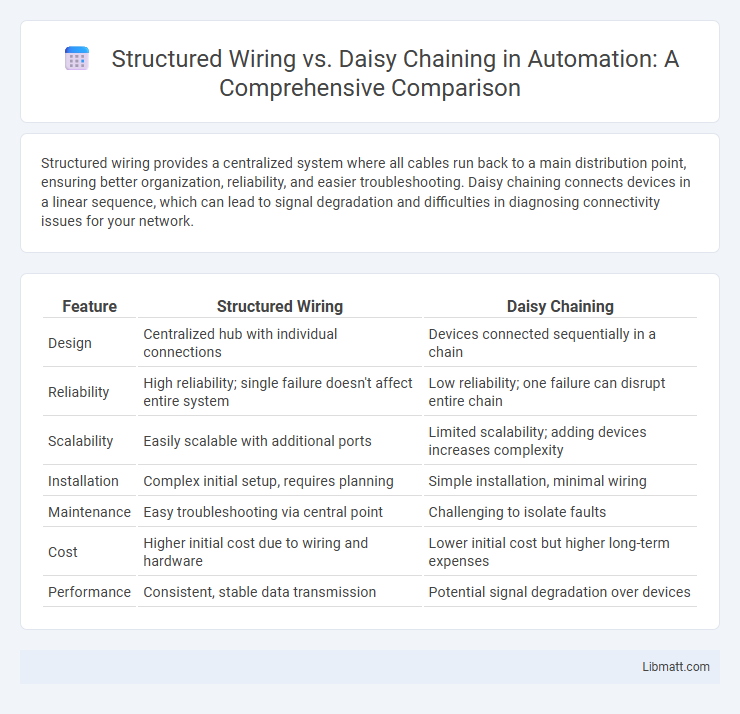Structured wiring provides a centralized system where all cables run back to a main distribution point, ensuring better organization, reliability, and easier troubleshooting. Daisy chaining connects devices in a linear sequence, which can lead to signal degradation and difficulties in diagnosing connectivity issues for your network.
Table of Comparison
| Feature | Structured Wiring | Daisy Chaining |
|---|---|---|
| Design | Centralized hub with individual connections | Devices connected sequentially in a chain |
| Reliability | High reliability; single failure doesn't affect entire system | Low reliability; one failure can disrupt entire chain |
| Scalability | Easily scalable with additional ports | Limited scalability; adding devices increases complexity |
| Installation | Complex initial setup, requires planning | Simple installation, minimal wiring |
| Maintenance | Easy troubleshooting via central point | Challenging to isolate faults |
| Cost | Higher initial cost due to wiring and hardware | Lower initial cost but higher long-term expenses |
| Performance | Consistent, stable data transmission | Potential signal degradation over devices |
Introduction to Home Wiring Methods
Structured wiring involves a centralized home wiring system where all cables run from a central location to individual outlets or devices, ensuring organized and efficient signal distribution. Daisy chaining connects devices or outlets sequentially along a single cable path, which can lead to signal degradation and reduced reliability over longer distances. Homeowners often prefer structured wiring for scalability and superior performance in networking, audio, and video installations.
What is Structured Wiring?
Structured wiring is a comprehensive system that organizes and integrates all the wiring in your home or office into a central location for easier management and improved performance. This method uses dedicated cables for different functions such as data, audio, video, and telecommunications, ensuring optimal signal quality and future scalability. Unlike daisy chaining, structured wiring enhances reliability and simplifies troubleshooting by preventing signal loss and interference.
What is Daisy Chaining?
Daisy chaining is a wiring method where devices are connected in series, with each device linked to the next in a single, continuous line. This setup can cause signal degradation and troubleshooting difficulties, especially in complex home or office networks. Structured wiring offers a more organized, star topology that enhances reliability and simplifies maintenance, unlike daisy chaining which often limits scalability and performance.
Key Differences Between Structured Wiring and Daisy Chaining
Structured wiring uses a centralized distribution point with dedicated cables running directly to each device or outlet, ensuring higher reliability and easier troubleshooting. Daisy chaining connects devices in series with a single cable linking each device to the next, which can lead to signal degradation and more complex maintenance. The key difference lies in structured wiring's superior scalability and performance compared to the limited flexibility and increased vulnerability of daisy chaining.
Pros and Cons of Structured Wiring
Structured wiring offers enhanced reliability and scalability by organizing all low-voltage cables into a centralized hub, reducing signal interference and simplifying troubleshooting. Your network benefits from future-proofing, as it supports easy upgrades and expansions without extensive rewiring. However, higher initial installation costs and the need for professional setup can be considered drawbacks compared to simpler methods like daisy chaining.
Pros and Cons of Daisy Chaining
Daisy chaining offers simple and cost-effective wiring by connecting devices in series, reducing the amount of cable needed and installation time. However, this method can create a single point of failure, where one disconnected or faulty device disrupts the entire chain. Your network may experience reduced performance and limited scalability compared to structured wiring setups.
Performance and Reliability Comparison
Structured wiring systems offer superior performance and reliability due to their organized layout, minimizing signal interference and ensuring consistent bandwidth across connected devices. Daisy chaining can cause signal degradation and increased latency as each device relies on the previous connection, leading to potential points of failure. High-quality structured wiring supports easier troubleshooting and scalability, enhancing long-term network stability and device performance.
Scalability and Future-Proofing
Structured wiring systems provide enhanced scalability by allowing easy addition or modification of individual connections without disrupting the entire network, making them ideal for future-proofing smart homes and office setups. Daisy chaining limits scalability as each device depends on the previous connection, increasing the risk of network failure and complicating upgrades or expansions. Investing in structured wiring ensures long-term flexibility and supports evolving technologies like advanced home automation and high-speed internet demands.
Cost Implications of Each Method
Structured wiring generally involves higher initial installation costs due to the need for dedicated cables and centralized hardware, but it offers better scalability and easier troubleshooting, reducing long-term expenses. Daisy chaining typically lowers upfront costs by using fewer cables and simpler connections but may increase maintenance and upgrade costs over time due to potential signal degradation and complexity in isolating faults. Considering total cost of ownership, structured wiring often proves more cost-effective for larger or more complex installations.
Which Wiring Solution is Best for Your Needs?
Structured wiring offers organized, centralized connectivity ideal for large homes and multiple devices, enhancing network performance and troubleshooting ease. Daisy chaining simplifies installation by connecting devices sequentially, suitable for smaller setups but can lead to signal degradation and complex maintenance. Choosing the best wiring solution depends on your home's size, device quantity, network reliability needs, and upgrade plans.
Structured Wiring vs Daisy Chaining Infographic

 libmatt.com
libmatt.com